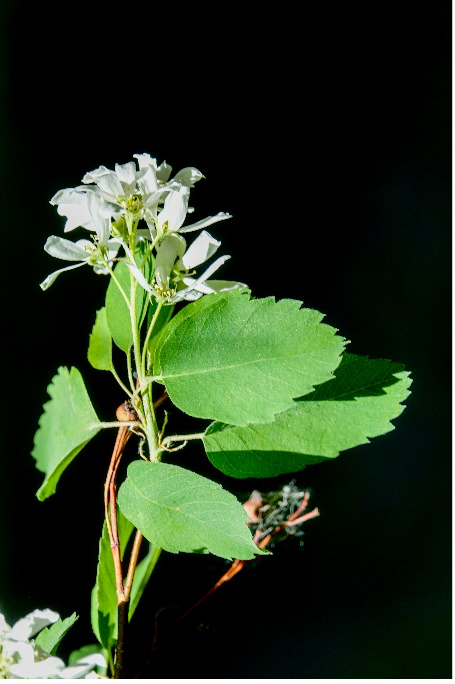Serviceberry
Serviceberry is in the Rose family and is one of the most common, if not the most conspicuous, summer berry plant in our valley. In early June these bushes flower, appearing like giant white popcorn, to adorn the landscape. They can grow up to 20 feet high and are found wherever there is a little moisture, but thrive along the shores of rivers, streams and lakes of our valley. The rose family (Rosaceae) accounts for at least fourteen of the fruit producing plants in Teton County. Serviceberry is one of my favorite fruits to harvest. It has a pleasing, sweet but subdued taste, it is a very firm berry so it can be picked casually without squishing between your fingers or in the basket. The berries can be eaten raw or transformed into syrup, jam, pie, and wine or added to baked goods. It does not spoil easily and can sit for days on the counter before you have to cook, dry or freeze the berry for later use. The berry, actually a pome, contains several small soft seeds that some find annoying but soften further with cooking. I enjoy making, and eating serviceberry pie but find it is best when mixed with other of your favorite berries; blueberry, raspberry, or huckleberry.
Serviceberry, Amelanchier alnifolia, Rosaceae or Rose Family. Aliases; Saskatoon, Utah, Shadberry, Shadbush, Juneberry.
Nomenclature – [Amelanchier ‘am’ prefix = "having two"], {alnifolia="alder-like foliage"}.
Fruit – Purple/black pomes 1/2” round and firm skinned, obvious crown at top of berry. The berry is not toxic but its close relative the Great Basin Serviceberry may be slightly so, probably because there is some amount of tannic acid in the berries.
Leaves – Deciduous, alternate, simple, 1-2", oval to round, top half rounded & coarsely toothed, long petioles, Winter - alternate buds with imbricate, ciliate-margined scales distinguishes it from chokecherry. During winter the plant produces alternate buds with imbricate, ciliate-margined scales distinguishes it from chokecherry.
Flower – White to creamy, sepals & petals (perianth) in fives, narrow and twisted, on small racemes, numerous stamens, 2-5 styles, ovary inferior, floral cup below flower. In Grand Teton National Park, serviceberry is in full bloom in the first week of June.
Stem & bark - Hard woody, reddish/dark gray stems.
Palatability – Very edible, extensively used by native peoples, an often-used food for a number of wildlife species. Bears and many bird species utilize the berry and the entire plant is palatable to and browsed by deer, elk, moose, mountain sheep, rabbits & rodents. To fully appreciate this berry you must exercise a little patience, wait until the berries are fully ripened. You will be rewarded with the delight of tasting one of the sweetest of our berries.
Use – A staple of indigenous natives, who made pemmican, dried cakes, pies, puddings, stews, and a purple dye from the berry. Because the wood is hard, tough, and elastic and branches straight, it was used for arrows, spears, & utensils. The serviceberry is one of only half dozen berry-plants, which produce enough fruits that it could be reliably harvested in quantities to be preserved for winter use.
The white flowers are borne at the end of long petioles on lateral racemes. Peddles are long and twisted giving the flower a disheveled appearance. The 1-2” oval leaves are characteristically toothed on the upper half.
On dry soils and where heavily browsed the shrub may only be 2-3 feet tall, but on preferred sites it grows into a proper tree. As the berries ripen, their color progressively changes from light green to reddish, finally becoming dark purple or black when fully ripe.
Ready to eat. In the late fall a Ruffed Grouse is looking for any late hanging berries.
Serviceberry, top, cross sectioned and bottom view.
Cross section of berry showing the grey/white flesh and seeds.
Seeds from the berry.











